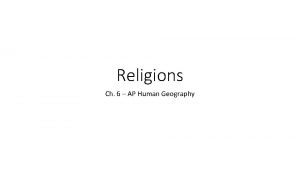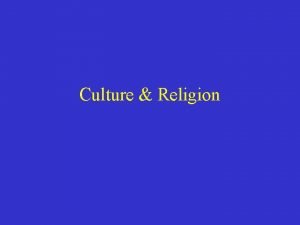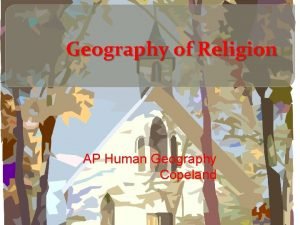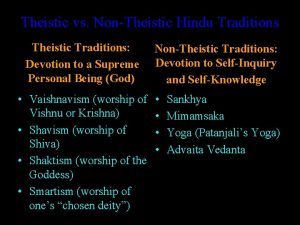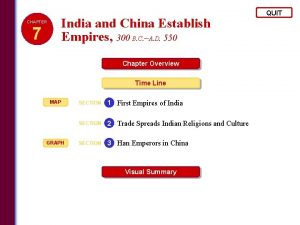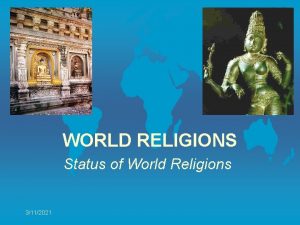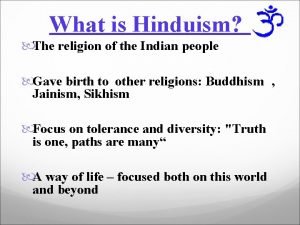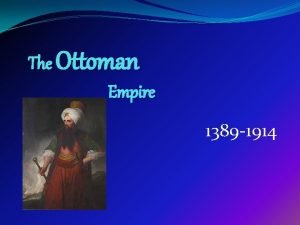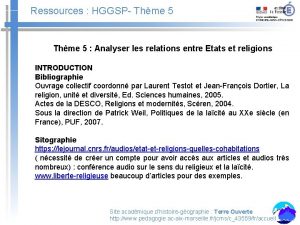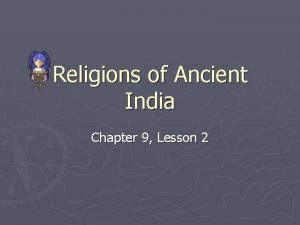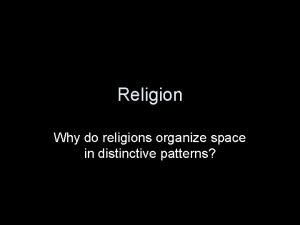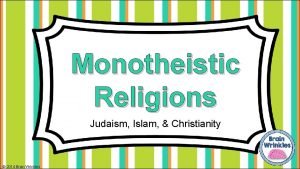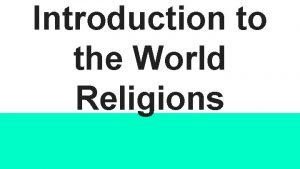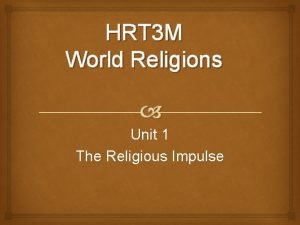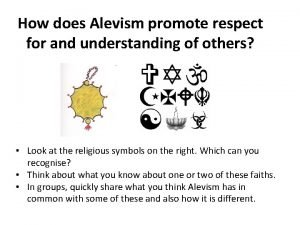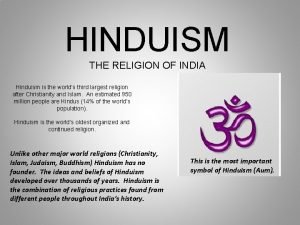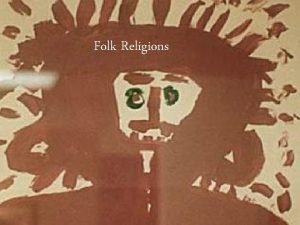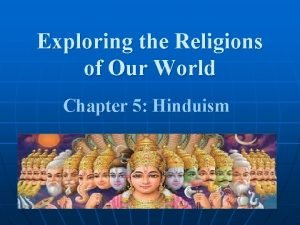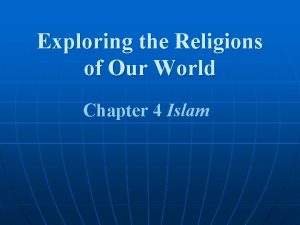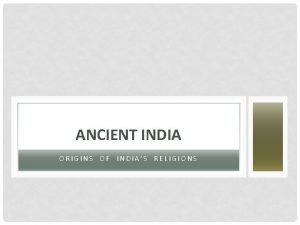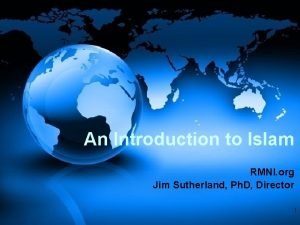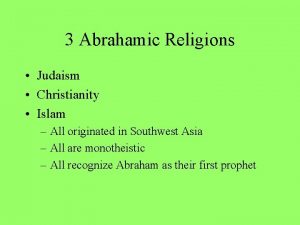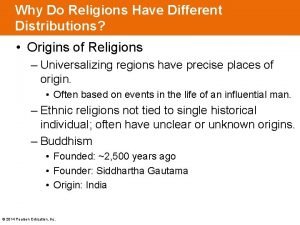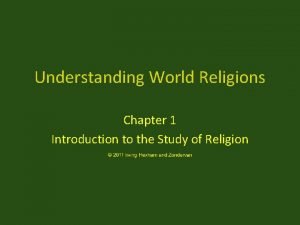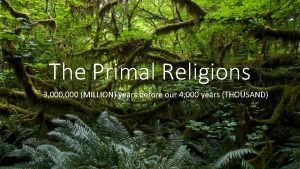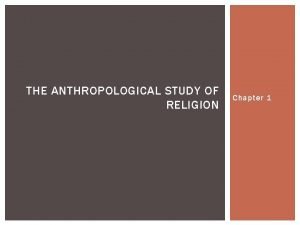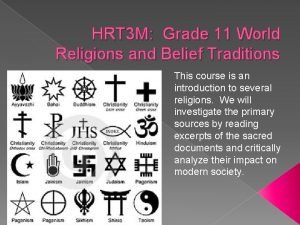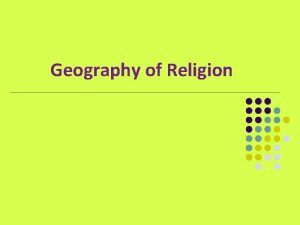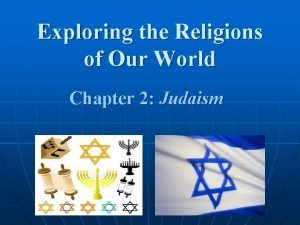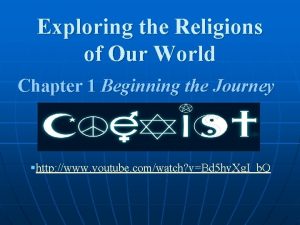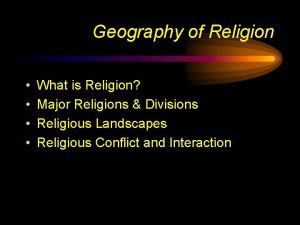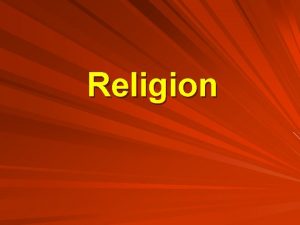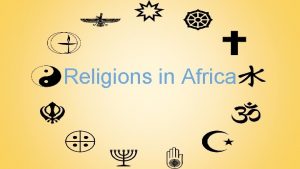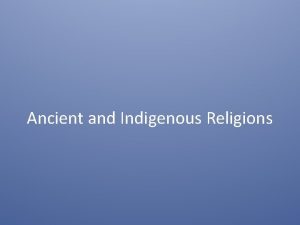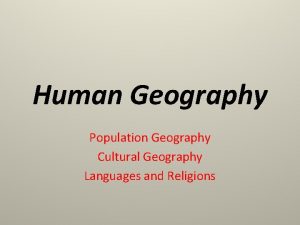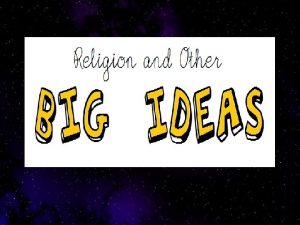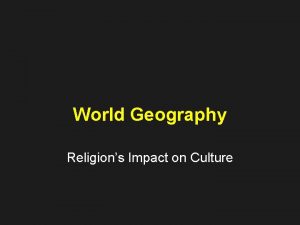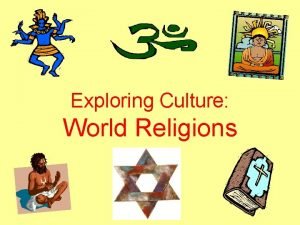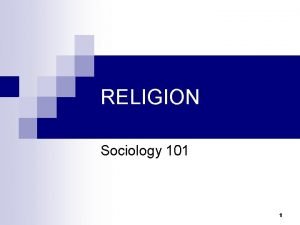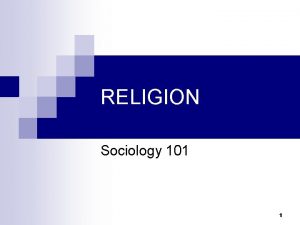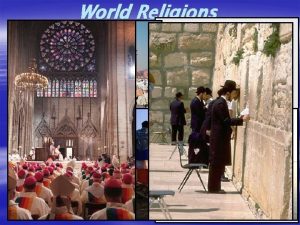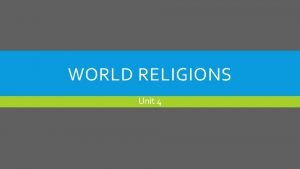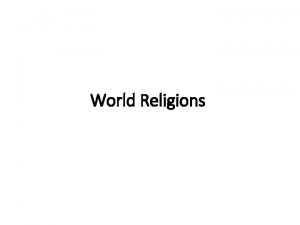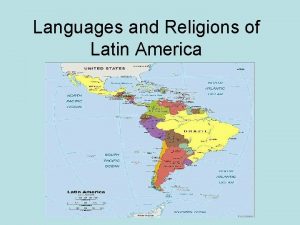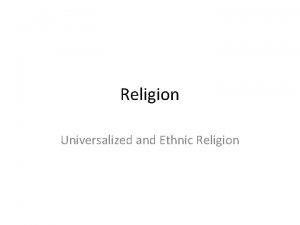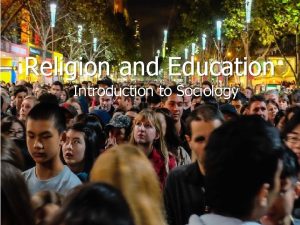The Geography of Languages and Religions Language Religion







































- Slides: 39

The Geography of Languages and Religions

Language & Religion Two most important forces that bond and define human cultures Each originated in a distinct hearth Two most important of all types of cultural regions

Defining Language - Pronunciation and combination of words used to communicate within a group of people Important cultural index – each language has a unique way of dealing with facts, ideas, and concepts. Structures individual perception of world

Language Regions Dialects Minor variations within a language Standard language Following formal rule of diction and grammar Official language Particular language for any given country Lingua franca - Current language of international discourse (English)

Linguistic Geography The study of different dialects across space Speech community – sounds are localized only among a group of people who speak together Isoglosses – boundary lines around places where speakers use linguistic features in the same way Parallel physical landscape features Geographical dialect continuum – chain of dialects or languages spoken across an area


World’s Major Languages 7, 299 distinct languages (ethnologue) 50% of world population speak one of 12 major languages listed Mandarin Chinese is largest with 885 million English is the primary language of 350 million and is the official language of about 50 countries



Language Development Protolanguage Common ancestor to any group of today’s languages Language family Languages related by descent from a common protolanguage Cognate – a word that clearly looks like or sounds like another word which it is related to Etymology- the study of word origins and history

Indo-European Language Family Identified by Sir William Jones, 1786 Proto-Indo-European • Common ancestor of many modern languages Grimm’s Law – rules to describe regular shifts in sounds that occurred when various Indo-European languages diverged Set forth by Jacob Grimm of the Brothers Grimm



Geography of Writing Orthography - system of writing Independent inventions of writing • Sumerians – Mesopotamia before (3000 B. C. ) • Olmec – Central America (650 B. C. ) Alphabets – system of letters which represent sounds Roman – modern western European languages Kazakhstan Cyrillic – Greek alphabet augmented by “Saint Cyril” Arabic – language of the Koran (uniting force) Non-alphabetic – each character represents a word or concept Chinese, Japanese, Korean



Toponymy- The study of place names Consists of: Natural features (Oak Bay) Origins/values of inhabitants (British Colombia) Belief structures, religions (Islamabad – place of Islam) Current or past heroes (St. Petersburg)



Linguistic Differentiation National languages Iceland Japan – exclusive to the country Nation building Philological nationalism – mother tongues have given rise to nationalism Postcolonial societies Imposed official languages by colonial ruler Not spoken by locals

Multiple Language States Polyglot states Having multiple official languages United States English always lingua franca Three major dialects in 13 colonies Non-English languages – creole, french, spanish


Language Vocab. British Received Pronunciation (BRP) – standard form of British speech used by upper class Britons Creole – 159 – mix of colonizers language and indigenous language of people being colonized Ebonics – African American dialect heavily influenced by Western African languages Extinct language 168 – once in use, even in the recent past Franglais – combination of French and English Ideograms – written character that usually represents a concept rather than a pronunciation Isolated language – a language that is not related to any other

Language Vocab. Cont… Language Branch – a collection of language related to a common ancestral language that existed several thousands of years ago Language group – a collection of languages within a branch that share a common origin, i. e. West Germanic Literary Tradition 146 Pidgin Language – includes grammar rules of lingua franca and some elements of a native language Spanglish – combination of Spanish and English (Cubonics) bacuncliner Vulgar Latin – non standard literary Latin spread by Roman Soldiers

World’s Major Religions Systems of beliefs guiding behavior Orthopraxy • Ethic and pscyhological based belief systems • (Shintoism, Taoism, Confucianism) Orthodoxy • Philosophical and theological based belief system Fundamentalism – strict adherence to traditional beliefs Secularism – lifestyle or policy that purposely ignores or excludes religious considerations



Judaism 14 million adherents Monotheistic Pentateuch First five books of the Old Testament Sects Orthodox - fundamentalist Conservative, Reform Israel Homeland for Jewish people Created 1948 Conflict between Israel and Palestine

Christianity Emerged from Judaism Coptic Church Founded in Alexandria in A. D. 41 Official religion of Roman Empire Facilitated geographical spread Dark Ages – church was the focal point for medieval people Protestant Reformation – Martin Luther Significant growth in Africa, Asia and Latin America

Islam Muhammad (570 -632) Allah –one god Cognate of “eloh” Five Pillars of Islam Belief in one God Five daily prayers Charity – generous alums Fasting during Ramadan Pilgrimage to Mecca (hajj) Sects Sunni – leader is chosen (85%) Shiite – leader is descendant of Muhammad (15%)

Hinduism & Sikhism Hinduism - Most ancient religious tradition in Asia Vedas – Hindu sacred texts Reincarnation, Karma Castes • • Brahman, priestly Kshatriya, warrior Vaisya, tradesman and farmer Sudra, servant and laborer Untouchables Sikhism Offshoot of Hinduism Guru Nanak – combined teaching of Hinduism and Islam

Buddhism Buddha – Enlightened One (Siddhartha- Hindu prince) Four Noble Truths Life involves suffering Cause of suffering is desire Elimination of desire ends suffering Right thinking and behavior eliminate desire 8 Fold Path can = Nirvana Diffused from India – East/SE Asia, Tibet, & Nepal

Other Religions Eastern Religions Confucianism – based on The Analects (governed China’s political and moral culture for 2, 000 years) Taoism – 3 rd Century, Tao-te Ching (Live in harmony w/ nature) Shinto – native to Japan, recognized emperor as divine Animism and Shamanism Animism • Belief in ubiquity of spirits or spiritual forces, hierachies of divinities Shamanism • Shaman – is a medium who goes into hupnotic trances – communes with the sprit world

Religion & Politics Freedom of religion – most countries guarantee this and observe a form of secularism (political boundaries stabalize religious affiliations) (see map pg 305) Theocracy Church rules directly (Iran) Separation of church and state Islamic is inherently political United States – several states established as theocracies • Treaty between US and Tripoli 1797 “U. S. gov is not based on Christian religion” Terrorism – Fundamentalism (failure of education

Social Impact of Religion Gender roles Women’s rights Diet Vegetarians Pork, beef cultural taboos, cows, pigs wars and witches Alcohol Ethics and morals Schools and institutions

Economic Impact Burial practices Protestantism and capitalism Catholic Church and capitalism Confucianism verses individualism

Religion and Environment Burial practices Origin of the world Relationship with nature Exploitive approach Adaptive approach

Religion Vocab. Cont… Animism – Believe that inanimate objects have spirits Autonomous Religion – self sufficient and interaction among communities is confined to little more than loose cooperation Branch – a large and fundamental division within a religion Caste – The class or distinct hereditary order into which a Hindu is assigned according to religious law Cosmogony – Set of beliefs concerning the origin of the universe Denomination – is a division of a branch that unites a number of local congregations in a single legal and administrative body Ethnic Religion – Relatively concentrated spatial distribution whose characteristics of the physical characteristics of the particular location

Religion Vocab. Cont… Fundamentalism - strict adherence to basic principles of a religion Ghetto – city neighborhood where Jews were forced to live Hierarchical Religion – well defined geographic structure that organizes territory into local administrative units Missionary – individuals who help to transmit a universalizing religion Pagan – follower of a polytheistic religion “countryside” Sect – small group that has broken away from a denomination Universalizing Religion – attempt to be global and appeal to all people wherever they live Liberation Theology – the idea that the Catholic church should work to liberate oppressed people through political activistm
 Taliban vs western values ap human geography
Taliban vs western values ap human geography Secneer
Secneer Distribution of religions in the world
Distribution of religions in the world Sikhism ap human geography
Sikhism ap human geography Difference between theistic and nontheistic religions
Difference between theistic and nontheistic religions Religions that believe in reincarnation
Religions that believe in reincarnation China 300 bc
China 300 bc Frq ap human geography format
Frq ap human geography format 5 themes of geography ap human geography
5 themes of geography ap human geography Stateless nation
Stateless nation Religion world map
Religion world map Who is a hindu
Who is a hindu Was the ottoman empire tolerant of other religions
Was the ottoman empire tolerant of other religions Hggsp analyser les relations entre états et religions
Hggsp analyser les relations entre états et religions Chapter 9 lesson 2 religions of ancient india
Chapter 9 lesson 2 religions of ancient india Why do religions organize space in distinctive patterns
Why do religions organize space in distinctive patterns Is reincarnation logical
Is reincarnation logical Abrahamic religions
Abrahamic religions Polytheistic religions
Polytheistic religions What do all religions have in common
What do all religions have in common Golden rule of all religions
Golden rule of all religions Is hinduism a religion
Is hinduism a religion Religion
Religion Exploring religions chapter 5 large
Exploring religions chapter 5 large Exploring religions chapter 4 large
Exploring religions chapter 4 large Why is hinduism an ethnic religion
Why is hinduism an ethnic religion Indias religions
Indias religions Major branches
Major branches Indias religions
Indias religions How many abrahamic religions are there
How many abrahamic religions are there Why do religions have distinctive distributions?
Why do religions have distinctive distributions? World religions chapter 1
World religions chapter 1 Primal religions
Primal religions Religion
Religion The sacred book of islam
The sacred book of islam Monotheism chart judaism christianity islam
Monotheism chart judaism christianity islam World religions grade 11
World religions grade 11 Where is christianity's hearth
Where is christianity's hearth Religion
Religion Exploring the religions of our world chapter 1 pdf
Exploring the religions of our world chapter 1 pdf
